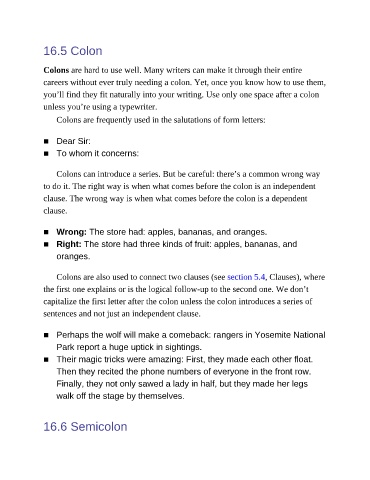Page 163 - Perfect English Grammar: The Indispensable Guide to Excellent Writing and Speaking
P. 163
16.5 Colon
Colons are hard to use well. Many writers can make it through their entire
careers without ever truly needing a colon. Yet, once you know how to use them,
you’ll find they fit naturally into your writing. Use only one space after a colon
unless you’re using a typewriter.
Colons are frequently used in the salutations of form letters:
■ Dear Sir:
■ To whom it concerns:
Colons can introduce a series. But be careful: there’s a common wrong way
to do it. The right way is when what comes before the colon is an independent
clause. The wrong way is when what comes before the colon is a dependent
clause.
■ Wrong: The store had: apples, bananas, and oranges.
■ Right: The store had three kinds of fruit: apples, bananas, and
oranges.
Colons are also used to connect two clauses (see section 5.4, Clauses), where
the first one explains or is the logical follow-up to the second one. We don’t
capitalize the first letter after the colon unless the colon introduces a series of
sentences and not just an independent clause.
■ Perhaps the wolf will make a comeback: rangers in Yosemite National
Park report a huge uptick in sightings.
■ Their magic tricks were amazing: First, they made each other float.
Then they recited the phone numbers of everyone in the front row.
Finally, they not only sawed a lady in half, but they made her legs
walk off the stage by themselves.
16.6 Semicolon

